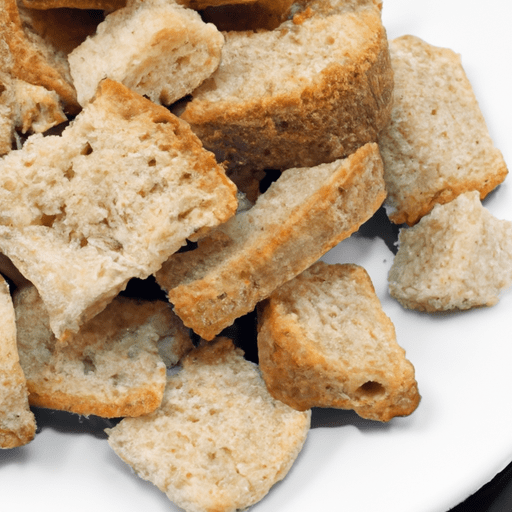Croutons: Small Bites of Crunchy Delight
Croutons, those delightful bite-sized pieces of toasted bread, have become a beloved culinary addition to many dishes around the world. These crunchy morsels not only add texture, but also bring a burst of flavor to salads, soups, and more. Let’s dive into the world of croutons and explore their taste, common uses, nutritional value, and some interesting history and facts.
Taste for Every Palate
Croutons are characterized by their crispy exterior and soft interior. When made with care, they offer a beautiful harmony between a golden-brown, toasted perfection and a gentle touch of seasoning. These seasoned bread cubes can display an array of flavors, ranging from classic salt and pepper to herbs like rosemary or thyme. Some adventurous souls even infuse them with garlic, cheese, or smoky spices to elevate the taste to new heights.
Versatility in the Culinary World
Croutons are incredibly versatile and find their way into various recipes, enhancing both taste and presentation. Here are some popular uses:
Salads: Croutons add a satisfying crunch to salads, complementing the fresh greens and colorful vegetables. They make an ordinary salad extraordinary by adding texture and depth to each bite.
Soups: Whether floated on top or scattered throughout, croutons bring an enjoyable contrast to the velvety smoothness of soups. They absorb the flavors of the soup while maintaining their delightful crunch.
Casseroles: Tossed into casseroles, croutons provide a gratifying contrast to the creamy or cheesy components. They create an enticing crust on top and offer a pleasant surprise with every mouthful.
Stuffing: A Thanksgiving staple, croutons are the backbone of many delicious stuffings. They absorb the savory juices and aromas, resulting in a perfect blend of flavors.
Nutritional Value
Though croutons are undeniably delicious, it’s important to consider their nutritional value. While they do provide carbohydrates and some dietary fiber, their overall nutritional profile varies based on the preparation method and ingredients used. It’s worth noting that commercially-made croutons might contain additional preservatives and unhealthy fats. If you’re concerned about the nutritional aspect, consider making your own croutons using whole-grain bread or opt for healthier alternatives like baked chickpea croutons.
A Dive into History and Fun Facts
Ever wondered about the origin of croutons? The precise history is unclear, but it is believed that croutons originated in France. The word “crouton” is derived from the French word “croûte,” meaning crust. Traditionally, the French prepared croutons by frying or toasting day-old bread, utilizing every bit of food to avoid wastage.
Here are a few more interesting facts about croutons:
- Croutons gained widespread popularity in the United States during the 1940s and 1950s, thanks to acclaimed chef Julia Child who featured them in her television cooking shows and cookbooks.
- Some creative variations of croutons include sweet croutons made with cinnamon and sugar, and even chocolate croutons for desserts.
- Chefs have gotten imaginative with their crouton shapes and sizes, crafting everything from small cubes and disks to hearts and stars, adding a touch of whimsy to their culinary creations.
Croutons, with their texture, taste, and versatility, continue to be an exceptional culinary addition. They offer a world of crunchy delight to classic and contemporary recipes, making them a success on many fronts. So let your creativity soar and experiment with making your own flavorful croutons, bringing that extra magic to your dishes!
Now go forth, arm yourself with bread and seasonings, and venture into the world of croutons. Your salads, soups, and other culinary creations will thank you in delightful crunches!
Croutons
Origin: Croutons are small, crispy pieces of toasted or fried bread that are commonly used as toppings or garnishes in various dishes. The term “crouton” is derived from the French word “croûton,” which means “crust.” It is believed that croutons originated in France during the Middle Ages.
Common Uses: Croutons are often added to salads, soups, and casseroles to provide texture and enhance flavor. They add a satisfying crunch and can absorb some of the liquid in a dish, which helps to maintain a pleasant texture.
Nutritional Benefits: Croutons are primarily made from bread, so their nutritional content largely depends on the type of bread used. They generally provide carbohydrates, some protein, and small amounts of fiber. However, since they are usually small in size, their overall nutritional contribution may be modest.
Unique Properties and Historical Significance: In the past, croutons were a way to repurpose stale or leftover bread, minimizing food waste. Today, they have become a popular ingredient in many cuisines worldwide. They can be seasoned with various herbs and spices, giving them unique flavors that can complement a wide range of dishes. In addition, croutons are often made from different types of bread, such as white, whole wheat, or sourdough, offering a variety of tastes and textures to suit different preferences.




Use the share button below if you liked it.
It makes me smile, when I see it.